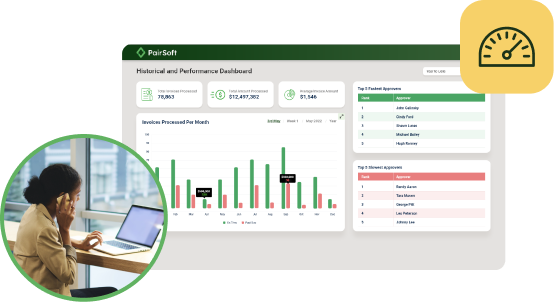
Wadih Pazos
Wadih founded both PairSoft and PaperSave. He is an avid technologist who specializes in streamlining operations and maximizing productivity.
View all posts by Wadih PazosWadih Pazos

The methods of record keeping in the business world have constantly evolved to become more efficient. With each successive step, companies have become more skillful at administrating, and able to do more with fewer resources.
In the modern business environment, there are dozens of ways to streamline and grow leaner and meaner, but few have as immediate a return as shifting from manual to electronic workflows. The benefits of making the switch are myriad, but here are just a few.Electronic workflow is key in accounts payable.
According to Docfinity, once an invoice arrives in accounts payable it has to be approved by someone before it can be paid. Signatures need to be gathered, purchase orders need to be matched, some invoices may not be paid until services are rendered or some may be outright rejected.
In traditional manual workflow, accounts payable has to deal with routing paper files to the right people for their approval. It can be easy to lose track of an invoice while it sits on a middle manager’s desk.
With an electronic workflow, invoices can be matched to purchases during the capture process automatically, according to Harvest Technology Group, allowing them to be immediately routed to the proper person for approval.
The authorized managers can then review and sign the documents from remote locations, saving time that would have ordinarily been spent shuffling papers from one office to another or waiting for the employee to physically make it into the office to sign a form.
An automated process can cut down on files being overlooked or delayed sitting on someone’s desk waiting for approval.
According to Business 2 Community, the results of an Aberdeen Research study said that it takes the average company 9.7 days to complete an invoice, costing $15.61 per invoice. The best companies, those with an effective electronic workflow, average 3.8 days at a cost of $3.09, a considerable savings, especially for businesses that process thousands of invoices per month.
Too often in today’s businesses, valuable information is stored in disparate places that do not connect, making the management of information a difficult task. Integrating an electronic workflow into your accounts payable system means data can be extracted and shared more easily between applications and employees.
Electronic systems that rely on capturing the information from a scan allow a layer of data entry to be removed, cutting down on mistakes and saving time.
An effective electronic workflow means automation. According to Harvest Technology Group, in many cases the software itself comes with the programming that allows it to find links between specific tasks and the workflow needed to accomplish them.
In an electronic workflow, all documents that are submitted to accounts payable are scanned at the point of origin, eliminating the need to keep and store reams of paper.
The technology allows a business to capture data on multiple pages of paper without heed to location or paper size, meaning that there are no transcription errors from an invoice to payment according to Docfinity. The data capture also facilitates instant lookup of any data from any authorized user, saving time and effort throughout the company.
In accounts payable, time is often money. Docfinity reported that making early payments often confers a discount and at the very least, avoiding late payments saves money, that alone is incentive to automate and speed up the process.
In a business using a manual workflow, opportunities to take advantage of early payment discounts are often curtailed by the sheer amount of time it takes to enter all of the data into the payables system. But when that data arrives via capture at the point of origin, it cuts that delay out of the process, allowing a much faster response by the department.


Many organizations start with manual receipt handling, fragmented card feeds and slow AP processes. Implement AI agents to auto-capture receipts, route approvals, enable punch-out buys and post to the ERP.
Result: faster batching, fewer errors and cost savings. “This saves us hours every month.”
Many organizations face slow, paper-heavy AP and fragmented procurement that waste time and inflate costs. AI Agents can automate approvals, PO matching and record sync to improve speed, accuracy and control. Client quote: “It freed up hours and made our process reliable.”
Operational drag and rising costs slow growth: teams waste time on manual tasks, misaligned priorities and opaque processes. AI Agents help automate routine work and coordinate actions across teams. “We’ve lost time to repeats and handoffs,” says a typical client.
Companies struggle with manual procurement, fragmented approvals, and costly integrations that slow growth and obscure spend. Our AI Agents streamline requisitions, POs, and invoice matching to cut manual work and improve visibility. “We were wasting time and missing insights,” says a client.

Many teams start with fragmented PO/AP systems, manual matching and delayed financial reporting. Deploying AI agents to automate PO checks, real-time encumbrance tracking and invoice matching reduces processing time and errors, delivering live budgets and faster closes. “Finally, we can see current balances and approve instantly.”
Many companies juggle growing invoice volumes and legacy systems. They struggle with manual processes, compliance gaps and limited headcount. Our AI Agents automate integrations, enforce rules and surface exceptions. The typical outcome: faster closes and measurable ROI. “We stopped chasing invoices.”